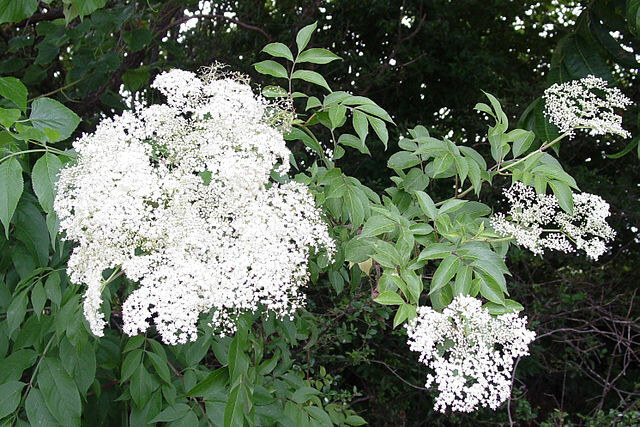Written by Don Richardson

 Elderberry (Sambucus Simpsonii)
Elderberry (Sambucus Simpsonii)Plant Type | Perennial Shrub |
Size | Upto 12’ tall - Spreads |
Sun Exposure | Full Sun - Part Shade |
Soil Type | all |
Soil pH | 6.8-7.2 prefers slightly acidic |
Bloom Time | Spring - Fall |
Hardiness Zones | 4a-10b Florida Native Plant |
Moisture | Moist, rich, well drained |
Cold/Heat | -20°F – |
Pollination | Self-pollinates |
Edible Plant | Yes – Berries only cooked |
Medicinal Plant | Yes |
Any reference to medicinal or culinary use of plants or plant parts should in no way be considered an endorsement by The Ocala Food Forest or its staff. Research is crucial in safe and proper consumption or experimentational use of any plant.
The Sambucus Simpsonii, or elderberry plant, is a deciduous shrub that is native to North America. The elderberry plant is a member of the Adoxaceae family and can grow to be up to 12 feet tall. The elderberry plant has dark green leaves and produces small white flowers that turn into dark purple berries. The berries of the elderberry plant are used in pies, jams, and wine. The elderberry plant is also known for its medicinal properties and has been used to treat colds, flu, and other ailments for centuries.
The History of the Elderberry Plant
The elderberry plant was introduced to North America by European settlers in the 1600s. The history of elderberries dates back centuries. Native Americans used elderberries in traditional medicine to treat a variety of ailments. The plant was also used by early settlers in North America as a food source. Elderberries can be made into jams, pies, wines, and cordials.
During World War II, British pilots ate elderberry jam to prevent getting homesick. It was thought that the sweetness of the jam would help boost morale. After the war ended, interest in elderberries declined due to their short shelf life and lack of availability.
In recent years, there has been a resurgence in interest in elderberries due to their health benefits. Elderberries are packed with antioxidants and vitamins C and E. They are also a good source of fiber and potassium. Studies have shown that elderberries can help boost the immune system, reduce inflammation, and fight off viral infections.
The Uses of the Elderberry Plant
The berries of the elderberry plant are used in pies, jams, and wine. In recent years, elderberries have gained popularity as a superfood due to their high levels of antioxidants and vitamins.
The elderberry plant is also known for its medicinal properties. Studies have shown that elderberry juice can help boost the immune system, reduce inflammation, and fight off viral infections. If you're looking for a delicious way to improve your health, add some elderberries to your diet!
How to Grow Your Own Elderberry Plant
If you're interested in growing your own elderberry plant, you'll be happy to know that they are relatively easy to care for. Elderberries prefer full sun but will tolerate partial shade. They prefer well-drained soil but are tolerant of a variety of soil types. Elderberries are generally low-maintenance plants but may need occasional pruning to keep them from getting too large.
Conclusion:
The Sambucus Simpsonii, or elderberry plant, is a deciduous shrub that is native to North America. The elderberry plant is a member of the Adoxaceae family and can grow to be up to 12 feet tall. The elderberry plant has dark green leaves and produces small white flowers that turn into dark purple berries. The berries of the elderberry plant are used in pies, jams, and wine. The elderberry plant is also known for its medicinal properties and has been used to treat colds, flu, and other ailments for centuries. If you're interested in growing your own elderberry plant, you'll be happy to know that they are relatively easy to care for.
The Sambucus Simpsonii, or elderberry plant, is a deciduous shrub that is native to North America. The elderberry plant is a member of the Adoxaceae family and can grow to be up to 12 feet tall. The elderberry plant has dark green leaves and produces small white flowers that turn into dark purple berries. The berries of the elderberry plant are used in pies, jams, and wine. The elderberry plant is also known for its medicinal properties and has been used to treat colds, flu, and other ailments for centuries. If you're interested in growing your own elderberry plant, you'll be happy to know that they are relatively easy to care for.









0 Comments